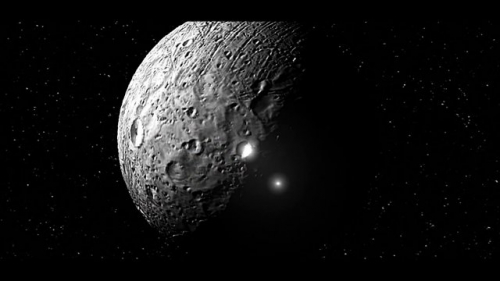By the title, I mean, what sort of body is it, and how did it form. Ceres is the largest body in the asteroid belt, and it is essentially spherical, from gravitational energy minimization. It lies at a distance at which the remaining bodies are mainly carbonaceous asteroids, and are made of rock with some water and organic material. It should be noted that the part of the asteroid belt closest to the star contains mainly silicaceous asteroids, so an interesting question is, how did these different bodies form? The issue is made more complicated because there are also some such as Vesta that appear to have an iron core. To get an iron core, the temperature of the body had to get above 1538 oC, yet the evidence from meteorites is the carbonaceous bodies never got above ~200 oC. How did all this happen?
In my Planetary Formation and Biogenesis, I supported the hypothesis that Vesta and one or two other bodies really formed much closer to the star, and were moved out by gravitational interactions and became circularized where they are now. If that is right, that gets rid of that problem. As to why, after forgetting about Vesta and similar asteroids, there are two major classes of asteroids that are quite different. Within my interpretation, I propose planetary formation starts basically through chemistry, and the bodies stick together initially through chemical (including physical chemical) interactions. As for these asteroids, I suggested they formed by different methods, and consequently should have different chemical composition. In particular, the carbonaceous ones formed as or after the accretion disk cooled down. The concept was that at the higher temperatures, organic materials such as methanol, known to be in the disk, pyrolysed on silica particles and formed tarry material, and later this tarry material permitted bodies to stick together. One possible reason why the bodies are so small is that the tar would only be sticky over a modest range of temperatures. The net result of this is, based on meteorite samples, the carbonaceous asteroids tend to be black, and have various small rock-crystals distributed through them. Accordingly, if you break the meteorite the interior remains black, or at least dark coloured.
The puzzle, for the moment, is that the space vehicle Dawn has observed bright spots on Ceres' surface. These are quite white, in amongst the otherwise depressing grey-black. The nature of them is not that difficult to explain. In my opinion, they are most likely to comprise exposed ice. The problem then is, how does ice get there? Carbonaceous chondrites have between 3 and 22% water in them, but this water level may be inflated because the rocks have been lying around on Earth for some time before being picked up. The density relative to water of Ceres is 2.17, which means that in the absence of an iron core, the composition is richer in silicates than anything else. (Granite and silica tend to have densities in the order of 2.5, while olivines/pyroxenes will be in the order of 3.3.). One possibility is that in differentiation, the ice melted and accumulated, like lava, as deposits. But if that were the case, why would not the impact simply remelt it and mix it with the silicates? That would leave at best very dirty ice.
The white spots appear to be within craters, so it is possible that the impacts have melted the water deeper below and subsequently water has flowed out and solidified. That requires the water not to be dirty, to get the bright spots, and that suggests there were richer deposits of ice at some depth below the surface, and after impact, the pressure of steam cleared a pipe through the rock, and later the residual water flowed to the surface. So, what are the options? As I see them, Ceres may be an abnormally larger carbonaceous asteroid and the water has been mobilized by impact. The other possibility is that Ceres started life in the Jovian accretion zone, and was thrown inwards, during which it picked up more dust. This assumes it started life a bit like Ganymede/Callisto (densities between 1.83 and 1.93), and gained more dust and silicates on its surface. My guess is it started life in the Jovian region because that is the easiest way for it to get so big. If this is so, Ceres is not a typical body within the carbonaceous asteroid distribution, and Dawn will add no more information as to their formation. What remains to be seen is what information Dawn can gain.
Assuming all goes well, I shall add a photo of such spots and you can form your own opinion. The photo is, of course, due to NASA. What do you think?

